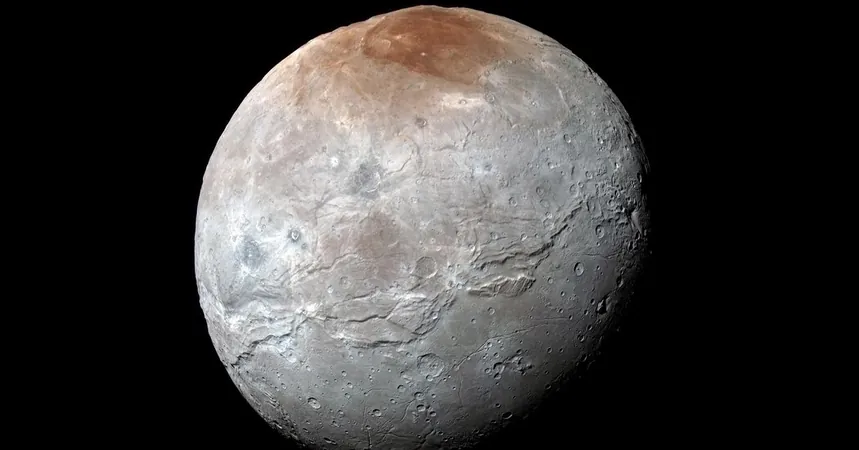
Pluto's Beguiling Dance: How an Ancient Collision Captured Its Largest Moon, Charon
2025-01-09
Author: Lok
Introduction
In a celestial tale woven over 4.5 billion years ago, the dwarf planet Pluto experienced an event that profoundly shaped its fate. Picture a swift encounter—a dance of sorts—with its largest moon, Charon. For a brief moment, they twirled together in space before parting ways in a grand cosmic choreography. This ancient celestial event may hold the key to understanding how Pluto and its five moons came to orbit the Sun.
The Mystery of Charon
At the heart of this mystery lies Charon, a moon that is remarkably large compared to Pluto, measuring about 750 miles across while Pluto itself stretches nearly 1,500 miles in diameter. 'The dynamic of Pluto and Charon is fascinating because Charon is nearly half the size of Pluto,' expressed Adeene Denton, a planetary scientist from the University of Arizona and the lead author of a groundbreaking new paper published in Nature Geoscience. 'There’s no other system like this except for Earth and its moon.'
Traditionally, scientists have proposed various theories regarding Charon's origins, including the possibility that it formed from debris surrounding Pluto or was gravitationally captured. However, these scenarios struggle to explain the remarkable size ratio. Could it be possible that Charon’s existence is better explained by a cataclysmic event similar to the one believed to have birthed Earth's moon?
Collision Dynamics
Given Pluto's and Charon's sizes, the conventional assumption would be that they would merge upon collision. However, Erik Asphaug, another planetary scientist from the University of Arizona, pointed out that the two celestial bodies’ toughness may allow for a different outcome. The research team constructed a model incorporating the unique geological features of both bodies, positing a scenario wherein Charon gently collided with Pluto at a comparatively sedate speed of 2,000 miles per hour—ten times slower than the impact event that formed Earth's moon.
'Imagine it as a ‘kiss and capture’,' Dr. Denton explained. The two might have remained in close contact for approximately ten hours, swinging around each other before gradually parting yet still remaining gravitationally bound—resulting in Charon's orbit around Pluto.
Pluto's Rapid Rotation
At that time, Pluto had a rapid rotation, completing a full spin every three hours, allowing the two bodies to engage in a celestial embrace three times before Charon began to drift away into a stable orbit. 'This angular momentum from Pluto’s rotation pushed Charon into a lasting orbital relationship,' Denton added.
Implications of the Collision
Bill McKinnon, a planetary scientist based at Washington University in St. Louis, echoed the significance of this model, declaring that collisional capture could very well be a common phenomenon in our solar system, especially among the numerous objects drifting through the Kuiper belt.
Importantly, this collision likely had dramatic geological implications, including a total resurfacing of Pluto, as ice was exchanged between both bodies in the aftermath. Dr. Denton remarked, 'The impact acted as a geological reset for the Pluto system.' Curiously, this event might have also facilitated the formation of Pluto’s four smaller moons—Nix, Styx, Kerberos, and Hydra—smaller companions that NASA’s New Horizons mission glimpsed during its flyby in 2015.
Conclusion
The discoveries presented by the research team not only unravel the mystery of Charon’s origins but could also reshape our understanding of how moons are captured by larger celestial bodies. 'This offers a fresh perspective on the physics of moon formation,' declared Asphaug. 'There’s a strong likelihood that we need to re-evaluate our assumptions, even concerning the formation of our moon.'
While more detailed studies of Pluto may someday provide further insights into this ancient cosmic dance, excitement persists in the scientific community. As our exploration of outer planets continues, perhaps we will unlock even greater mysteries waiting in the vast, uncharted expanse of the solar system. Stay tuned—new discoveries could be just a space mission away!


 Brasil (PT)
Brasil (PT)
 Canada (EN)
Canada (EN)
 Chile (ES)
Chile (ES)
 Česko (CS)
Česko (CS)
 대한민국 (KO)
대한민국 (KO)
 España (ES)
España (ES)
 France (FR)
France (FR)
 Hong Kong (EN)
Hong Kong (EN)
 Italia (IT)
Italia (IT)
 日本 (JA)
日本 (JA)
 Magyarország (HU)
Magyarország (HU)
 Norge (NO)
Norge (NO)
 Polska (PL)
Polska (PL)
 Schweiz (DE)
Schweiz (DE)
 Singapore (EN)
Singapore (EN)
 Sverige (SV)
Sverige (SV)
 Suomi (FI)
Suomi (FI)
 Türkiye (TR)
Türkiye (TR)
 الإمارات العربية المتحدة (AR)
الإمارات العربية المتحدة (AR)